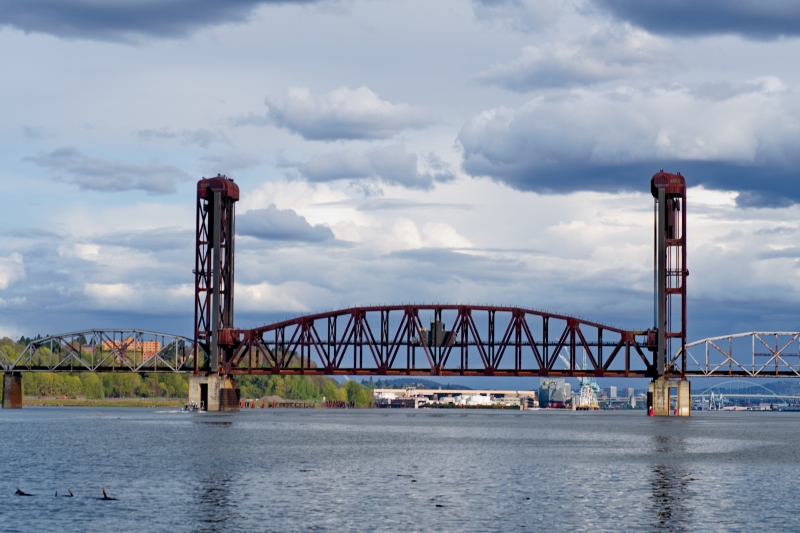On April 22, 2018, a team of people from a diverse suite of organizations from within and outside of NOAA began packing and loading gear, trailering and cleaning boats, and wrapping up preliminary paperwork. Made up of field biologists, toxicologists, injury assessment specialists, data managers, and field technicians, the team had just completed a week in the field as part of a major study to help determine the impacts to Endangered Species Act-listed juvenile Chinook salmon from exposure to contaminants as they out-migrate through the Portland Harbor Superfund site via the Willamette River.

A highly industrialized area, the Portland Harbor Superfund site extends from downtown Portland to the Willamette’s confluence with the Columbia River. Since the early 1900s, numerous facilities have released oil, polychlorinated biphenyls (PCBs), polycyclic aromatic hydrocarbons (PAHs), heavy metals, pesticides, and other hazardous substances into Portland Harbor. Last month’s field work was part of the natural resource damage assessment (NRDA) being conducted by the Portland Harbor Natural Resource Trustee Council. The council, which includes five Indian tribes, the State of Oregon, the U.S. Department of the Interior, and NOAA, was established after Portland Harbor was listed as a Superfund site in 2000.
Early on, the Trustee Council identified salmon — specifically, juvenile salmon — as a key species of interest for the damage assessment. Available scientific evidence indicates juvenile Chinook salmon within Portland Harbor have higher tissue levels of contaminants when compared to tissue levels from juvenile Chinook salmon collected upstream of the site. Scientists are concerned that exposures to these compounds may be adversely affecting juvenile Chinook as they move through the system. The objectives of this study are, in particular, to update information on the extent to which wild, sub-yearling Willamette River juvenile Chinook stocks are being exposed to contaminants and whether these exposures are impairing growth. If so, the ability of these fish to survive as they enter the lower Columbia River Estuary may be compromised.
Planning for study design began in 2017. Logistical planning ramped up shortly thereafter. The magnitude of the study, timing of the out-migration of the fish, and the uncertainties associated with changing river and weather conditions all presented challenges. In addition, there were the typical needs associated with field work; transportation, gear, equipment, data processing, and staffing all had to be addressed, leading to questions such as: Where to field process the captured fish? How to balance the various required staffing needs (data management, field lab experience, field sampling experience, boat operations, etc.)? Where to house the field team? Where to keep the boats? How to get staff and gear to and from the study location? The list went on and on.
Ultimately, two separate week-long sampling events were planned, with a third as a backup. Yet in the end, amazingly, all the work was completed during the first event. This was only possible through a combination of many individuals and organizations stepping up and working as a team. The OR&R Assessment and Restoration Division provided support for technical and logistical planning, field operations, and overall strategic framework in close collaboration with the NOAA Northwest Fisheries Science Center. The Science Center provided the principle investigator (Dr. Jessica Lundin), field and lab experts, and equipment (including a boat). The NOAA Restoration Center provided logistical planning support and field team staff. The NOAA Office of General Counsel provided advanced and real time assistance in negotiating access to private property. The Portland Office of the National Weather Service provided, via their staff river hydrologist, detailed information and assessments of river condition trends. The U.S. Fish and Wildlife Service provided experienced field biologists and boat operators, a boat and a trailer for use as a field lab. And perhaps most importantly, the U.S. Coast Guard Marine Safety Unit / Portland provided the field team with access to their facility.
The degree to which the Coast Guard’s assistance enabled the team to complete this effort cannot be overstated. The team had 24/7 access to the Coast Guard facility, including parking for vehicles, boat trailers, the field lab trailer; and moorage access for the two boats; access to the vessel and the vehicle cleaning pad, first aid facilities, restrooms, base store, and more. The Coast Guard also invited the team members to avail themselves of their galley facility for lunches. In addition, the Coast Guard personnel were extremely hospitable, engaging, and interested in the team's work.
So what comes next? Staff at the Science Center have begun processing and analyzing samples, of which there are many. In addition, all the data captured in the field and generated as a result of the various laboratory analyses will need to be incorporated into OR&R’S data management system, DIVER — which stands for Data Integration Visualization Exploration and Reporting — after undergoing quality assurance and control. Finally, and perhaps most importantly, the data will need to be carefully analyzed and interpreted in order to understand how these fish may be impacted by exposures to contaminants as they pass through the Superfund site. Stay tuned for more as the findings of this study become available.
For more information on the Portland Harbor waste site, visit the Damage Assessment, Remediation, and Restoration Program site.
Robert Neely is an environmental scientist with the NOAA’s Office of Response and Restoration. He has experience in ocean and coastal management, brownfields revitalization, Ecological Risk Assessment, and Natural Resource Damage Assessment. He’s been working with his co-trustees at Portland Harbor since 2005.

